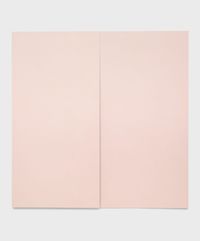

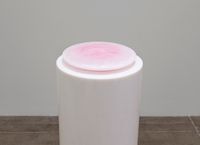
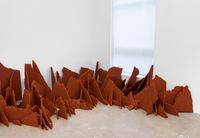

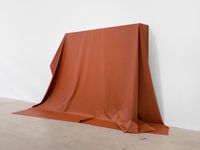
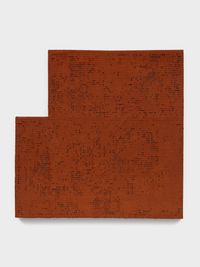

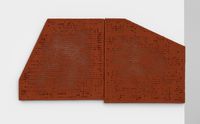



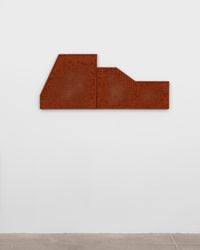
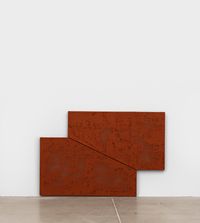

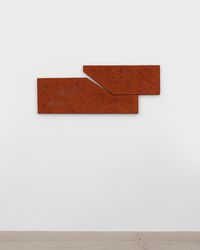
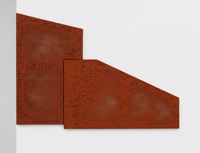

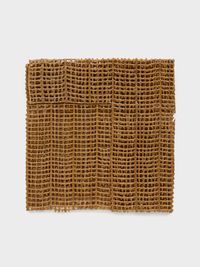
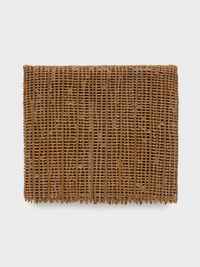

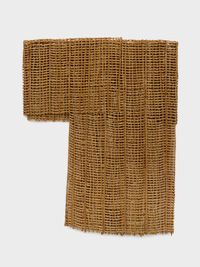
Marian Goodman Gallery in New York is pleased to announce the upcoming exhibition by Delcy Morelos and Ettore Spalletti, opening Wednesday, 13 March, and on view through 20 April 2024.
Esa esquina soy yo will present works that span three decades and offer a dialogue between these two artists. The exhibition highlights distinct practices and processes, traversing past and present, bringing to light dual influences and trajectories, from Andean cosmology to explorations of color, geometries and relationship with space. In this exhibition we see their dynamic activation and a sublime transcendence.
In his work, where painting and sculpture merge together, Ettore Spalletti (1940-2019) offers a dialogue between classicism and contemporaneity. In his search for an essential dimension and a new idea of spatiality, there is a constant dialogue with the art of the past and, in particular, with the masters of Italian Renaissance art, from Piero della Francesca to Raphael. His language eliminates all forms of rhetoric, recovering geometries and archetypal forms according to concepts that clearly distinguish him from Minimal Art.
Fundamental to his poetics are the transformation of materials (alabaster, onyx, marble) and, above all, the definition of a particular painting technique. The painted surfaces, obtained through multiple layers of color impasto repeated over several days at the same time, following the final abrasion, are characterized by the presence of a certain amount of white pigment that, as it breaks, becomes a source of light. The light that comes from within the work intertwines itself with the variations of natural light that add color to color. Far from being absolutely monochrome, Spalletti's painted surfaces offer a texture which gives breath to the image.
Color in Spalletti always reveals a depth, just as in the words of Paul Valéry -'Ce qu'il y a de plus profond dans l'homme, c'est la peau'- with which the artist titled his solo exhibition at Galerie Marian Goodman in Paris in 2018. Contrary to contemporary trends, Spalletti spent his life in his native places, loving to call his studio home.
Delcy Morelos' indigenous traditions inform her memories of her homeland and its hierarchies of skin, race, land and violence. Invoking a bodily materiality in her layers of paint poured and slowly applied to textile or fabric supports, the artist lets the paint drip, pool and solidify, creating vast pictorial fields that move away from the picture plane and extend to ceramics, textiles and large-scale immersive installations. Her evocative treatment of colour suggests both the body and the earth, revealing what is most sacred to the artist and drawing a connection between the body and violence. Morelos' chromatic exploration of the colour red, for example, especially in her early works, implies blood and matrilineal force. Taking cues from Andean ancestral traditions, Morelos favours textiles and fabrics and natural materials such as plant and mineral fibers, earth, clay, and soil. Conceiving of a fictional and primordial cosmos, her experiential artworks are made for the human senses and create 'an alchemy that awakens different emotions in each person.'
Spalletti's pink diptych, Carta Rosa, 1998, is the anchor of the North Gallery space, in dialogue with Morelos' series, Eva, from 2013. The work is made with an impasto of colour painted on the front and back of two slender wooden paper panels that move in response to atmospheric shifts. The colour pink is, as the artist tells it, the colour of the human skin 'which never has a fixity of its own but is continually transformed through the mood we experience.' Mobile, 1994, a sculpture painted in a diverse shade of pink, offers an example of Spalletti's research into the relationship between sculpture and spatiality. Next to these, Morelos' work, Eva, 2013, extends into three-dimensional space and volumetric form. A fabric structure, suspended in space, stands across from of a series of works, Eva. 1-10, 2013. Objectively geometric, they are made with mineral powders and acrylic, with earth tones that recall soil and colour, life and the female body. As Morelos said, the earth contains in its womb the very cycles of life, death and rebirth, and is a feminine deity.
In the North Gallery room, a series of works by Morelos made with thick layers of acrylic on cotton thread, titled Doble Negacion/Double Negation, 2008, bring the minimalist grid closer to the dense tactility of paint droplets, which serve to structure the surfaces of the lattice works. In the center of the room is Spalletti's Colonna, portacipria, 2016: a circular form of pink onyx, concealing within it a powder of the same colour, rests on a white marble column, a form dear to Spalletti's heart, which has spanned the entire history of art and architecture.
In the South Gallery is Senza titolo, azzurro, 1990, with its three-sided bull frame. Light blue for Spalletti, as the artist put it, is 'an atmospheric colour, in which we are continually immersed, it is the colour of the sky [...] ours is a sky of meditation, when you take a walk by the sea towards evening the line of the horizon is no longer visible, the sea joins the sky. You feel that space never ends, there is no image, but if you try to pierce the blue with a finger, what do you find? You are in contemplative reality. I think of Beato Angelico.' In Colonna Tagliata, 2016, however, the theme of the column returns. The cut side is painted and confirms the continuous crossing between painting and sculpture in his work.
Morelos' Eva, 2013, acrylic on jute, an installation of the same title made with earth and binder on chipboard, marks Morelos' decisive shift from the pictorial plane to structures in space, anticipating her sculptural practice and large-scale experiential and multisensory installations.
At the Pulitzer Arts Foundation in St. Louis, Interwoven, a solo exhibition of Morelos' work, is scheduled to run from 8 March through 4 August 2024. Delcy Morelos: El Abrazo, on view at Dia Chelsea through 20 July 2024, features two immersive earth-based installations, Cielo terrenal (Earthly Sky, 2023) and El abrazo (The Embrace, 2023). A catalogue will be published in conjunction with the exhibition.
Press release courtesy Marian Goodman
24 West 57th Street
New York, 10019
United States
www.mariangoodman.com
+1 212 977 7160
+1 212 581 5187 (Fax)
Monday – Saturday
10am – 6pm